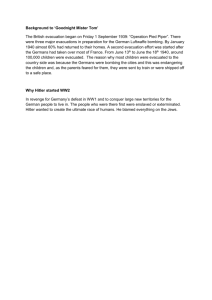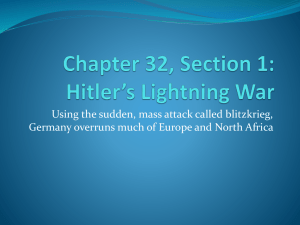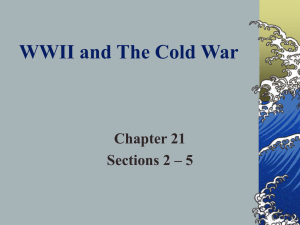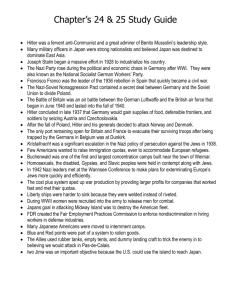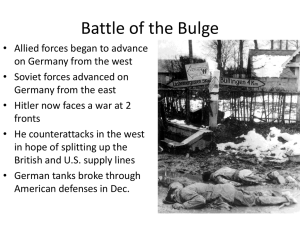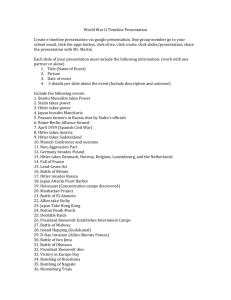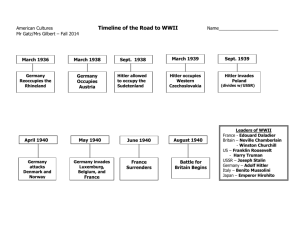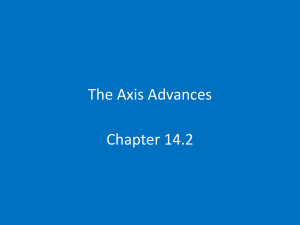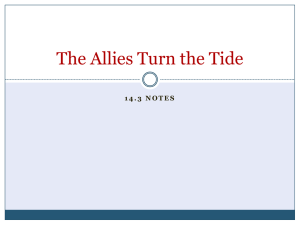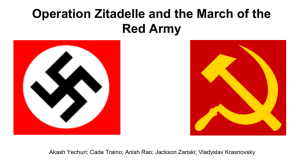World War II
advertisement
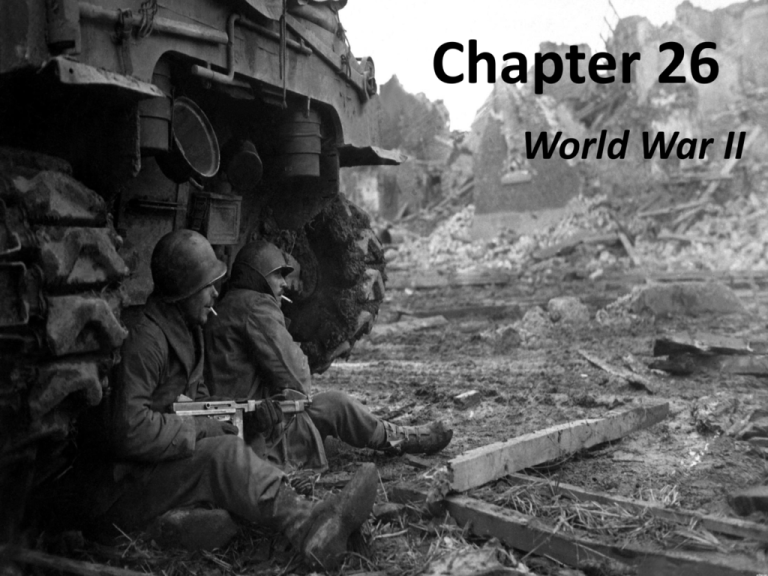
Chapter 26 World War II Section 1 Paths to War Early Indications • Germany increases it military from 100,000 to 550,000 troops, UK, France and Italy condemn this, but are incapable of any action due to their own domestic issues (Depression). • Germans begin to mobilize in Rhineland (Which was directly against the treaty of Versailles). • European powers did not take any direction against Germany in hopes that policy would be a peaceful way of achieving goals and not war. Failure of Appeasement Hitler joins forces with Austria forcing them to forma new Nazi government in March of 1928. The Munich conference was the high point of western appeasement, when Neville Chamberlan (British PM) returned to England and boasted of peace treaties with Hitler, Chamberlain believed that the Germans would not go into war. Does Appeasement work? Why yes or no? The Soviets and Hitler Fearing that the “west” and the Soviet Union would create an alliance, Hitler made his own agreement with Joseph Stalin. 1939, Germans and Soviets sign a nonaggression Pact. Hitler was successful in getting the treaty signed by offering the Soviets Eastern Poland and the Baltic states, giving Germany the perfect opportunity to attack Poland (which they do on Sept.1) Japans Path to War 1931 Japan had seized Manchuria using the “Munken Incident” where Japanese soldiers disguised as Chinese bombed a Japanese railway. Japan renamed Manchuria, Manchukoku. Japan went to War with China in 1936 taking over the communist government, in 1937 seizing the capital Nanjing in December. New Asian Order Japan begun a new order in East Asia, comprising of Japan, Manchuria and China. Japans goal was to modernize the rest of Asia by seizing Soviet Siberia, in order to take over Siberia Japan had planned on attacking the Soviets with Germany. However, the nonaggression pact signed between the Soviets and Germans in 1939 made Japanese leaders rethinking their goals. Japan changed its goals towards attacking southward to gain raw materials in southeast asia. By 1940 Japan had gained part of French Indochina. The US in retaliation began economic sanctions, restrictions towards Japan, who was using oil and scrap iron from the US. Japan now is caught in a dilemma to give up raw materials from the US or to stop exploiting southeast Asia. After much debate, Japan decides to launch a surprise attack on the US and Europe Blitzkreig Attack Blitzkreig, “Lightening War” used armored columns called Panzer divisions supported by airplanes. -Within four weeks the Polish surrendered -The Germans attacked the Netherlands, Belgium, France and Luxembourg in 1940. -The Germans signed an armistice in June of 1940 with the French controlling around 60% of French soil. The US & Isolationism The French and the British were being defeated by the Germans in Europe, however the US chose to continue to pursue isolationism, the US had passed various neutrality acts in congress which prohibited them from joining Wars. However, by 1940, many of these acts were being repealed as the US supplied food, ships, planes and weapons to Great Britain Battle of Britain 1940 August: Luftwatte, German air force bombs British air, naval bases, harbors, communications and war industries. The British suffering critical losses. In September, Lufwattes began bombing British cities, in hope to break British morale, however this provided time for the British to rebuild. Ultimately, the British were able to rebuild and to fight off Hitler, Hitler having no choice but to postpone the invasion of Britain indefinitely. Attacking the Soviets By 1940 Hitler was convinced that the British remained in war in hopes of Soviet support, and that if the Soviets were defeated the British would surrender. Although the invasion was delayed (Due to problems in the Balkans, with Italians failing an invasion of Greece) Hitler begun attacking the Soviets in 1941. -German soldiers captured 2 million Russian soldiers capturing Ukraine, Leningrad and Moscow. Cold Soviet Winters However, the German attacks were haulted in 1941 due to the cold weather. The cold weather in Russia will play an even larger role later on in the War. Pearl Harbor 1941 December, Japan launches an aircraft attack on the US naval base in Pearl Harbor. -The same day as the attack Japan invades Dutch East Indies and assaults the Philippines. -By 1942, almost all of Southeast Asia had gone to the Japanese. Japan names their colonies as the Greater EastAsia Co-prosperity Sphere. The Americans In reaction to Pearl Harbor, public opinion in the United States swayed heavily towards joining the war. Although damage was down, the Japanese had not decisively destroyed Pearl Harbor and the US had enough military for a swift counter attack. In reaction to the Americans declaring War to Japan, Germany declares war on America hoping that US involvement in the pacific would distract the US from Europe. By 1941, another European conflict had extended itself to become a global conflict. The Grand Alliance Great Britain-United States-Soviet Union, decided to work together and ignore political differences. Agreeing to fight until the axis powers German, Italy and Japan would surrender unconditionally. German Setbacks 1942 Fall: The tides begin to turn in the War -German forces are stopped in Northern Africa and forced to retreat, eventually surrendering in 1943 May. -In the East, Hitler's attacks on Stalingrad were stopped (1942-43 Feb.) The poor weather conditions and Soviet counter attacks took out the German troops forcing them back to where they were before June 1942. Major Turning Point: of the war camera bout in the Battle of Midway Island where US planes destroyed four attacking Japanese aircraft carriers and established naval superiority in the pacific. Douglas MacArthur, a US general helped the US move into New Guinea through he Philippines and stage navy attacks on Japanese-held islands. This style of attack was also known as “Island Hoping”. Asia Final Days of Battle Europe 1 By 1943 the tides have turned against the Axis Powers. The allied forces had managed to conquer the southern area of Italy as the allied troops began an invasion of mainland Italy in September (1943). -After the fall of Sicily Mussolini is removed from office and placed under arrest by Victor Emmanuel III, the King of Italy. -However, Germans had come into Italy to free Mussolini and set up defensive lines in Rome, Rome did not fall to the allies until June 1944. Final Days of Battle Europe 2 Since the autumn of 1943, the Allies had been planning on invasion of France from Great Britain, across the English Channel. The allies focused on landing on Normandy. -Within three months, the Allies had landed two million men and a half a million vehciles and were able to break through German defensive lines. The Allies were able to liberate Paris by end of August. Soviet Union 1943 Summer: Hitler gambled on attacking through heavy tanks, however they were defeated in the Battle of Kursk. Soviet troops occupied Warsaw in January 1945 and entered Berlin in April. By Jan. 1945 Adolf Hitler had moved into a bunker in Berlin and commit suicide. End of War in Asia 1 In Asia the US forces began to go on the offense in 1943. The war official came to the end in 1945, when President Harry Truman who had become president from April, made the decision to drop the nuclear/atomic bomb on Japan. The US dropped two bombs, one on Hiroshima and one on Nagasaki. Japan surrender on August 14th. World War II was over and Seventeen million had died in battle. Perhaps twenty million civilians had perished as well…. The estimated final losses of life was a total of fifty million.
